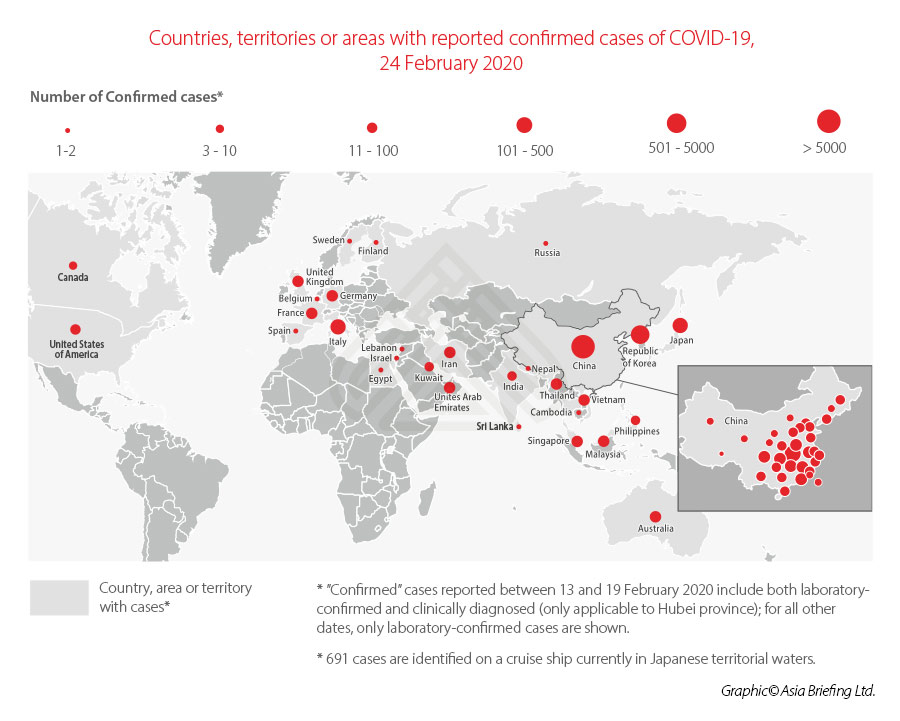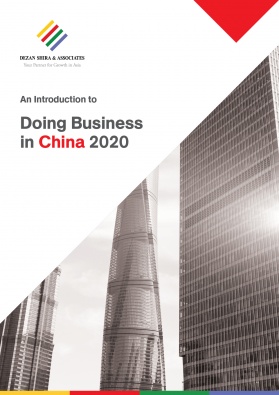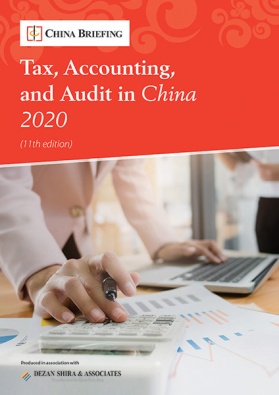Fed Up with Covid-19? Here Are the China Plus One Alternatives
Op/Ed By Chris Devonshire-Ellis
The Covid-19 outbreak has disrupted business plans for 2020 and injected a huge amount of uncertainty into the China business arena – exactly what foreign investors and the Chinese government do not wish to see happen. It will usher in a period of foreign investors seeking to build-in options to their existing China production capabilities, unless China can show that its two-decade old reliability and productivity era can continue.
It is worthwhile noting that at present, a little over one percent (80,000 globally, 77,658 in mainland China) of total cases have occurred outside China. For reasons yet to be understood, Covid-19 has proven especially prevalent in Hubei province itself. Time may yet reveal a larger spread, but at this juncture it appears to make sense that isolating business production externally from China makes sound sense.
These then, are the China Plus One alternatives. We will be following this article up with a deeper dive China Plus One series over the coming two weeks. A complimentary subscription to China Briefing will ensure you receive these and can be obtained here.
Below are a large number of complimentary business magazine downloads, written by professionals at Dezan Shira & Associates that deal with all aspects of relocating from China and introduce procedures on how to operate in new markets throughout Southeast Asia. A short description of contents of each is included. If you wish to download any of these – they are all free – then subscribe to this service here to register and begin reading.
Moving Your Manufacturing from China
This can be a sensitive subject, not least to any existing Chinese suppliers who may see an exit as a loss of business and might not be fully cooperative. Advance planning over issues, such as handling the tooling, molds, IP, and so on need to be addressed, as well as the practical issues of dealing with staff reductions, physical relocation, shipping, exporting and importing machinery – including what may now be second-hand equipment – to a new location.
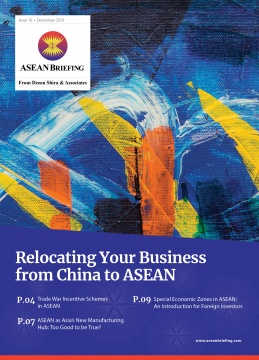 Relocating Your China Business to ASEAN
Relocating Your China Business to ASEAN
ASEAN countries have become an alluring destination for Chinese-based businesses looking to benefit from the cost-savings of relocating all or part of their production facilities to Southeast Asia amid the brewing US-China trade war. In this issue of the ASEAN Briefing magazine, we begin by introducing the different incentives issued by ASEAN countries to attract investments from the spillover of the trade war. We then analyze productivity levels in ASEAN and what impact this has on businesses relocating to the region. Finally, we focus on special economic zones (SEZs) in ASEAN and their increasing importance in garnering foreign investments at a time of global economic uncertainty.
Best Practice in ASEAN Import and Export
The rules and regulations when operating from ASEAN are of course different to those in China. In the magazine below we identify common best practice scenarios as used by some of our most successful and experienced clients in the region
 Export-Import Procedures in ASEAN: Best Practices
Export-Import Procedures in ASEAN: Best Practices
In this issue of ASEAN Briefing magazine, we highlight the region’s export and import procedures for the benefit of trading businesses. We begin by outlining the export procedures in each ASEAN member state. Next, we focus on import procedures in each ASEAN country. Finally, we discuss the importance of meeting the region’s Rules of Origin (RoO) criteria for exporters and importers looking to take advantage of the individual ASEAN member states’ FTAs as well as the bloc’s regional FTAs.
Leaving China and Closing Your China Business
It is sad, but some foreign investors in China may feel it best to shutter their doors and reinvest elsewhere. It is a procedure that needs to be handled correctly – otherwise debts can come back and haunt both individual persons such as chief representatives, legally responsible persons, and create some serious future problems. It is better to leave on good and settled terms, in compliance with Chinese laws on liquidations and closures. Procedures need to be followed.
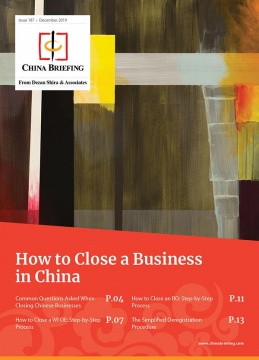 How to Close a Business in China
How to Close a Business in China
Companies in China may want to end their operations for various reasons. Irrespective of what factors might trigger this decision to shut down the business, investors cannot simply walk away without following proper closure procedures. Not properly closing the company will not only attract stringent penalties from the government’s tax and regulatory bodies, but also do lasting damage to the reputation of the company. Moreover, the legal representative and the financial associates of the entity will face difficulty in various occasions. In this issue of China Briefing magazine, we walk foreign investors through the process of closing down their company in China.
What are my Asia alternatives?
It depends, and is a bespoke decision. Local research needs to be taken as concerns operational costs, available infrastructure, production capabilities, and other bench-marking. Dezan Shira & Associates has a specific business intelligence division that works for clients to look at options and help identify the optimum location from the choices available. Our BID team works for SOEs, MNCs, as well as Governments and understands what clients are looking for. Email us at asia@dezshira.com to discuss what you are looking for and the scope of research needed.
ASEAN as a free trade option
ASEAN, which comprises the ten southeast Asian countries of Brunei, Cambodia, Indonesia, Laos, Malaysia, Myanmar, Philippines, Singapore, Thailand, and Vietnam enjoys free trade among its members and, additionally, has Free Trade Agreements with China, India, Australia, and New Zealand. This means that businesses relocating to ASEAN may still be able to service clients in China and elsewhere.
There are other business positive tax issues that need to be examined, such as applicable Double Tax Agreements. These are important to establish as part of the due diligence process in choosing an alternative to China – through the use of differing tax structures within these agreements, it can be possible to increase operational profitability by as much as 5-10 percent. This is done by charging royalties (which is one reason why it is important to register trademarks and patents) to the new business from your overseas HQ. Why? Because DTA provide for a lower (withholding) tax rate than the typical applicable profits tax rate payable if you just leave the money in situ.
The US, for example, has double tax avoidance treaties with ASEAN members Indonesia, Philippines, and Thailand. In the European Union, DTA are negotiated by individual member states, and many of these have DTA with ASEAN members, as does the UK and many other countries. Please email us asia@dezshira.com for assistance in identifying applicable tax advantages in different Asian countries.
Asian manufacturing alternatives
Our firm has numerous offices across ASEAN and Asia, and all of the major manufacturing countries, but we are not present in all Asian nations. Countries such as Bangladesh, Cambodia, Laos, and Myanmar are interesting, but probably left to the experienced local Asia hand at the time being, although we have partner firms that can assist in these countries and others – if this is what you need. Otherwise, our services and capabilities extend to the following Asian nations:
Indonesia
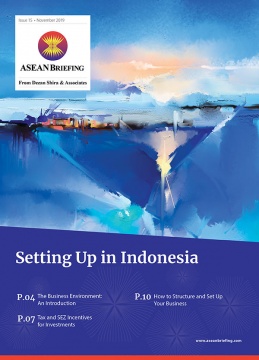 Setting Up in Indonesia
Setting Up in Indonesia
After overcoming the Asian financial crisis in 1998, Indonesia developed into a vibrant democracy with the largest and most dynamic economy in Southeast Asia. The country’s GDP has grown at a consistent pace at just above five percent in the past year. In this issue of the ASEAN Briefing magazine, we begin by introducing Indonesia’s business environment by highlighting its major industries as well as its tax and visa regulations. We then analyze the various tax incentives offered to foreign investors, in addition to the incentives provided in special economic zones (SEZ). Finally, we focus on corporate establishments and the set-up process investors need to follow if they are looking to establish a legal presence in the country.
India
India, like China, offers a huge domestic consumer market, and just in electronics alone is worth about US$400 billion per annum. In 2019, it became the world’s largest consumer market after the US and China. It also has a Free Trade Agreement with ASEAN. With worker salaries at about 30 percent of those in China’s Guangdong Province, and a total workforce of about 400 million, its position as workshop of the world is rapidly developing. India’s bilateral trade with China is just under US$100 billion, and is growing.
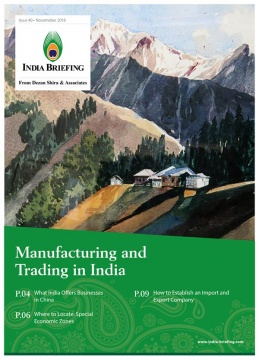 Manufacturing and Trading in India
Manufacturing and Trading in India
In this issue of India Briefing magazine, we discuss the advantages India offers as an alternative destination for businesses in China planning to relocate or diversify their existing operations due to rising production costs. Further, we highlight the advantages of operating in India’s special economic zones and discuss the factors a company must consider before choosing an ideal SEZ location. Finally, we look at the relevant steps and procedures for establishing an import-export company in India.
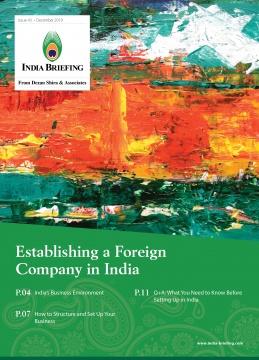 Establishing a Foreign Company in India
Establishing a Foreign Company in India
India is an attractive destination for foreign investors due to its large consumer-oriented market, low labor costs, and rising global competitiveness. Despite the recent dip in the growth rate, India features among the top 10 countries for global FDI. Further, with more sectors being liberalized and a focus on improving the ease of doing business environment, India offers a stable base of operations for investors seriously considering the Asian market. In this issue of India Briefing, we provide information on establishing a company in India. We discuss the country’s current business environment and why India has emerged as a preferred investment destination for foreign companies, in addition to the entity structures available to foreign companies in India and explain their functionalities and requirements.
The Philippines
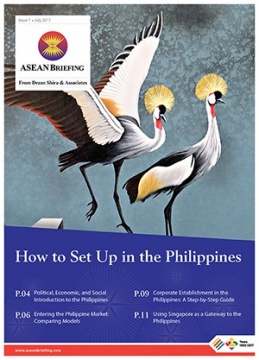 How to Set Up in the Philippines
How to Set Up in the Philippines
Here we provide an introduction to the Philippines as well as analyze the various market entry options available for investors interested in expanding to the island nation. We also discuss the step-by-step process for setting up a business entity in the Philippines, highlighting the various statutory requirements for overseas investors. We also review the potential for Singapore to serve as a viable base to administer investors’ ASEAN operations.
Singapore
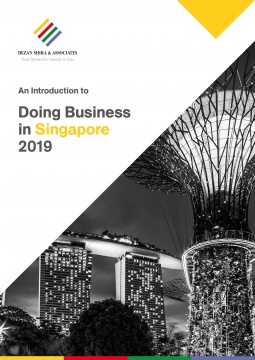 An Introduction to Doing Business in Singapore
An Introduction to Doing Business in Singapore
Singapore is the financial and services hub for the ASEAN region, making it a primary destination for service industries. This guide provides readers with an overview of the fundamentals of investing and conducting business in Singapore and outlines the city-state’s role as a trading hub within ASEAN. The guide explains the basics of company establishment, annual compliance, taxation, human resources, and social insurance in the city-state. A detailed examination of the role of Singapore’s many double tax treaties and its position within the ASEAN free trade area as well as its relationship with China and India are also covered.
Thailand
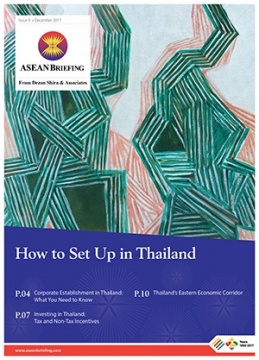 How to Set Up in Thailand
How to Set Up in Thailand
In this magazine we analyze the various market entry options available for investors interested in expanding to Thailand. We also discuss the various tax and non-tax incentives on offer for foreign investors in the kingdom. Finally, we discuss the salient features of Thailand’s Eastern Economic Corridor development plan and highlight the key incentives on offer for overseas investors.
Vietnam
Vietnam has been a major recipient of China relocating businesses. But as the principal cities like Ho Chi Minh become expensive and their industrial parks full, foreign investors need to plan for alternatives. Larger companies may also consider taking a shortcut by buying existing facilities.
 Import and Export in Vietnam
Import and Export in Vietnam
Vietnam has followed an export-led growth model, combining trade liberalization and policies to attract foreign direct investment to spur exports. This has allowed Vietnam to accelerate growth in recent years, emerging as a clear leader in low-cost manufacturing and sourcing. In this issue of Vietnam Briefing magazine, we examine Vietnam’s import and export landscape and the top sectors for trade. We then look at import and export procedures, business models, duties, exemptions, and tax rates that traders need to be aware of.
 How to Set Up in Vietnam
How to Set Up in Vietnam
Vietnam’s economy continues to perform well, sustained by ongoing domestic reforms, a stable government, and the diversification of foreign direct investment in the country. With such growth, new market entrants see Vietnam as a good opportunity to establish in Asia or diversify their regional presence. In this issue of Vietnam Briefing magazine, we detail company structures in Vietnam and outline the most efficient structure for foreign businesses that seek to take advantage of the country’s investment climate.
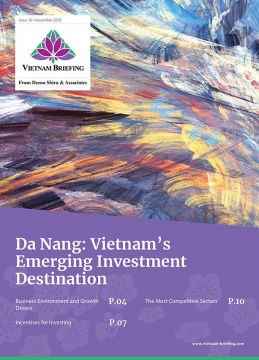 Da Nang: Vietnam’s Emerging Investment Destination
Da Nang: Vietnam’s Emerging Investment Destination
Da Nang has emerged as an attractive investment destination for domestic and international investors, followed only by the capital Hanoi and commercial hub Ho Chi Minh City. In this issue of Vietnam Briefing magazine, we examine the central city of Da Nang and its investment opportunities. We highlight Da Nang’s business environment and growth drivers, before exploring the city’s incentives and industrial parks. We conclude with an overview of the sectors that are attracting investment, describing the scope for investors that are looking to invest in this region.
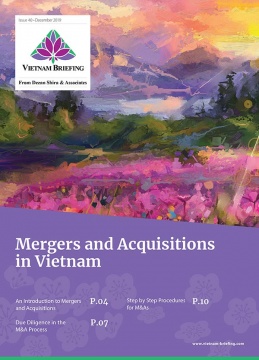 Mergers and Acquisitions in Vietnam
Mergers and Acquisitions in Vietnam
Foreign investors in a hurry to break new ground in ASEAN are eyeing investments into existing businesses and facilities. It is in this context that mergers and acquisitions (M&A) have become an increasingly popular investment route into the country. With an M&A, investors can enjoy preexisting access to customers, suppliers, and distribution channels. In this magazine, we look at the legal foundation for M&As, including the basic laws that govern M&A activity. We then look at the legal and financial aspects of the M&A process including the due diligence process that goes into an M&A. We conclude with step by step procedures for M&As and post-merger considerations in Vietnam.
There are numerous alternatives for international sourcing companies, traders, and manufacturers to look for within Asia – if considering a China alternative. Our firm has offices throughout the region and is familiar with the trade issues between the US, EU, China, and alternative Asia together with the legal, tax, and operational issues concerned when making such a change. Please contact us at asia@dezshira.com for assistance.
This article has been updated and adapted from our earlier piece “Relocating Your China Sourcing and Manufacturing to Asia” published on February 7, 2020.
Related Reading
- A New Perspective: How do ASEAN Economies Stand Against China’s Regions?
- The RCEP: Impacting ASEAN’s Supply Chains and Business Environment
- Trade War Incentive Schemes in ASEAN
About Us
China Briefing is written and produced by Dezan Shira & Associates. The practice assists foreign investors into China and has done since 1992 through offices in Beijing, Tianjin, Dalian, Qingdao, Shanghai, Hangzhou, Ningbo, Suzhou, Guangzhou, Dongguan, Zhongshan, Shenzhen, and Hong Kong. Please contact the firm for assistance in China at china@dezshira.com.
We also maintain offices assisting foreign investors in Vietnam, Indonesia, Singapore, The Philippines, Malaysia, and Thailand in addition to our practices in India and Russia and our trade research facilities along the Belt & Road Initiative.
- Previous Article Covid-19 Contingencies: Assistance with Relocating China Assembly to Vietnam
- Next Article China Manufacturing versus Mexico Manufacturing: Who Wins?

